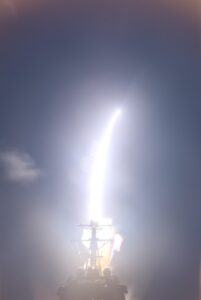The Missile Defense Agency (MDA) and U.S. Navy successfully intercepted an Intercontinental Ballistic Missile (ICBM)-type target with a Standard Missile-3 (SM-3) Block IIA missile over the Pacific Ocean on Nov. 16.
The test, designated Flight Test Aegis Weapon System-44 (FTM-44), had an ICBM-representative target launched from the Ronald Reagan Ballistic Missile Defense Test Site, at the Kwajalein Atoll in the Marshall Islands towards the ocean area northeast of Hawaii.

MDA said the USS John Finn (DDG-113) Aegis Ballistic Missile Defense (BMD) system-equipped destroyer used the engage-on-remote capability, receiving tracking data from the Command and Control Battle Management Communications (C2BMC) network, and then launching an SM-3 Block IIA which destroyed the target.
The Defense Department said that, based on preliminary data, the test met its primary objective: to demonstrate the ability of the SM-3 IIA to intercept an ICBM target. MDA said program officials will keep evaluating system performance based on telemetry and other data taken from the test.
Congress mandated what became FTM-44 in the fiscal year 2018 defense authorization act to test the feasibility of using an SM-3 IIA to defeat an ICBM threat before the end of 2020. This test was originally scheduled for May, but was delayed due to restrictions related to the COVID-19 pandemic.
In April, MDA disclosed most of its flight tests planned for fiscal year 2020 and 2021 were affected by DoD COVID-19 restrictions, with FTM-44 the first to be affected (Defense Daily, April 24).
The SM-3 was originally designed to counter intermediate-range ballistic missiles in the midcourse phase of flight with the Block IIA version a cooperative U.S.-Japan program to increase its speed and range.
“This was an incredible accomplishment and critical milestone for the Aegis BMD SM-3 Block IIA program,” MDA Director Vice Adm. Jon Hill said in a statement.
Hill also underscored DoD is looking into the possibility of supplementing the Ground-based Midcourse Defense (GMD) system for homeland missile defense by fielding additional sensors and weapons “to hedge against unexpected developments in the missile threat.”
The GMD system currently uses Ground-Based Interceptors (GBIs) to target ICBM threats.
This Aegis SM-3 IIA test against an ICBM target demonstration “is a step in the process of determining its feasibility as part of an architecture for layered defense of the homeland.”
In April, Deputy Assistant Secretary of Defense for Nuclear and Missile Defense Policy Robert Soofer noted “if the SM-3 IIA is capable of intercepting a North Korean-representative ICBM threat, this opens up some possibility to use the SM-3 IIA as an underlay to the GMD system” (Defense Daily, April 22).
Soofer said if FTM-44 proved successful, DoD would go to Congress and explain the concept of operations. He said one could imagine deploying the systems on ships where they are already deployed, but this requires ships to be in a certain location to actually defeat ICBMs.
Soofer said the SM-3 IIA capability is in the late midcourse terminal phase of ICBM flight and could operate after a GBI attempt.
“In other words, whatever you couldn’t intercept with the GBI you might get another shot with the IIA missile,” he said.
At the time, Soofer said ultimately the U.S. probably needs SM-3 IIs deployed ashore as an underlay to GMD, rather than exclusively relying on Aegis-equipped destroyers.
The prime contractor for Aegis is Lockheed Martin [LMT] while Raytheon Technologies [RTX] builds the SM-3 IIA and Northrop Grumman is the prime contractor for the Intermediate-Range Ballistic Missile (IRBM) and ICBM targets used in these tests.
“This first-of-its-kind test shows that our nation has a viable option for a new layer of defense against long-range threats,” Bryan Rosselli, vice president of Strategic Missile Defense at Raytheon Missiles & Defense, said in a statement.
The company also noted its sensors participated in the test from Low Earth Orbit, which detected and tracked the target while relaying data to decision makers.
“As the ICBM target prime contractor for the Missile Defense Agency, we understand how critical it is to launch a realistic threat target to ensure our nation’s defense systems work when called upon,” Scott Lehr, vice president and general manager, launch and missile defense systems at Northrop Grumman, said in a statement.
Northrop Grumman said its IRBM target is air-launched from a C-17 aircraft and has supported three ICBM and five IRBM target launches. The company has 18 more target launches on contract for future MDA tests